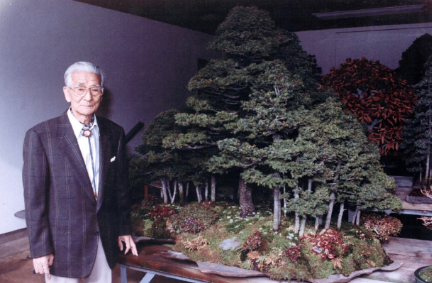At the annual National Bonsai Foundation Board of Directors meeting in August, we had the pleasure of honoring three directors who have retired from the board: Larry Ragle, Bill Valavanis and Jane Yamashiroya. We are grateful for the directors’ dedication to fostering a worldwide appreciation of peace and friendship through the art of bonsai. Please join us in reflecting on their contributions to the bonsai community over the years.
We have opened up the comment board below should you like to share your messages.
Larry Ragle (1982-2020)
Larry Ragle joined NBF so he could contribute to the mission of elevating and expanding the value of bonsai on a global scale. He was one of the original board members when NBF was founded, and both he and his wife Nina have been very involved in the bonsai community. Ragle felt his directorship was an important step to honor his sensei, bonsai masters John Naka and Harry Hirao.
He sees NBF as the soul of the National Bonsai Museum and thanks NBF Vice President Marybel Balendonck for her encouragement and guidance. Ragle appreciates the heartwarming support he and NBF received during fundraising events that honored bonsai masters like John Naka, Harry Hirao and George Yamaguchi.
“It has been a delight to see the Museum become a reality and watch all the improvements with so many dedicated volunteers,” he says. “It has been an honor to have played a small part, along with the rest of the bonsai community and beyond, to help make NBF the quality organization it has become.”
Bill Valavanis (1998-2020)
Bill Valavanis originally joined NBF to help promote the Museum and bonsai through his extensive connections in the bonsai community. Valavanis’ favorite memory as a director is when he served as National Chair of the selection committee to assemble the initial 56 trees that formed the Museum’s collection of North American Bonsai more than 30 years ago.
Valavanis fondly remembers when he and bonsai master Yuji Yoshimura compiled a list of 16 recommendations to revitalize the Museum’s collections and facilities. Valavanis is the third and only living inductee into the U.S. National Arboretum National Bonsai & Penjing Museum’s National Bonsai Hall of Fame.
“Although I am no longer a director, I will continue to support and assist NBF to sustain the National Bonsai & Penjing Museum,” he says. “I am honored I had the opportunity to share my experiences and knowledge gained during my 58 years of bonsai study with NBF for more than three decades.”
Jane Yamashiroya (2010-2020)
Jane Yamashiroya and her husband Roy became hooked on bonsai after attending a class on bonsai basics. They joined a bonsai club and spent their spare time improving skills. Eventually Ted Tsukiyama invited them to join the Hawaii Bonsai Association and informed them about NBF.
Yamashiroya would come to serve as HBA’s president and as a bonsai instructor and international consultant for the World Bonsai Friendship Federation, all the while attending myriad bonsai conventions, getting to know bonsai senseis and joining the NBF board. The highlight of her tenure was traveling to Japan, China and South Korea to raise funds for the renovation of the Japanese Pavilion.
“It was an honor and a privilege to have served on the NBF Board,” Yamashiroya says. “When I began, there were only a few women in the beginner’s class but now it is equally divided. I hope to motivate the new members to carry the torch and go beyond Hawaii to study and expand their skills.”
We are grateful for all of the hard work and thoughtful consideration these three board members have contributed to the NBF governing body over the years. We hope our strong relationships with them will continue to blossom.
At our annual meeting we also paid tribute to the work of Dr. Carl Morimoto, who has served as an NBF director since 2006 but stepped into the Vice President role in 2011. As of August 2020, Dr. Morimoto has retired as vice president, but we are pleased that he will remain on as a director.
Dr. Carl Morimoto, Vice President (2011-2020)
Bonsai master Harry Hirao encouraged Dr. Morimoto to join NBF so he could support the maintenance of the bicentennial bonsai gift from Japan. Being involved with NBF gave him opportunities to visit the Museum and see the bonsai close up. He is appreciative of working with the NBF executive committee and Museum staff, especially when supporting former NBF President Felix Laughlin in the communications and customs observed in Japan.
“The Museum’s Japanese white pine, or Yamaki pine, is known as the ‘Peace Tree’ because it survived the Hiroshima atomic bomb,” Dr. Morimoto says. “I also survived the bomb in Hiroshima, so I feel some destiny in being one of the NBF directors supporting the Museum.”






















